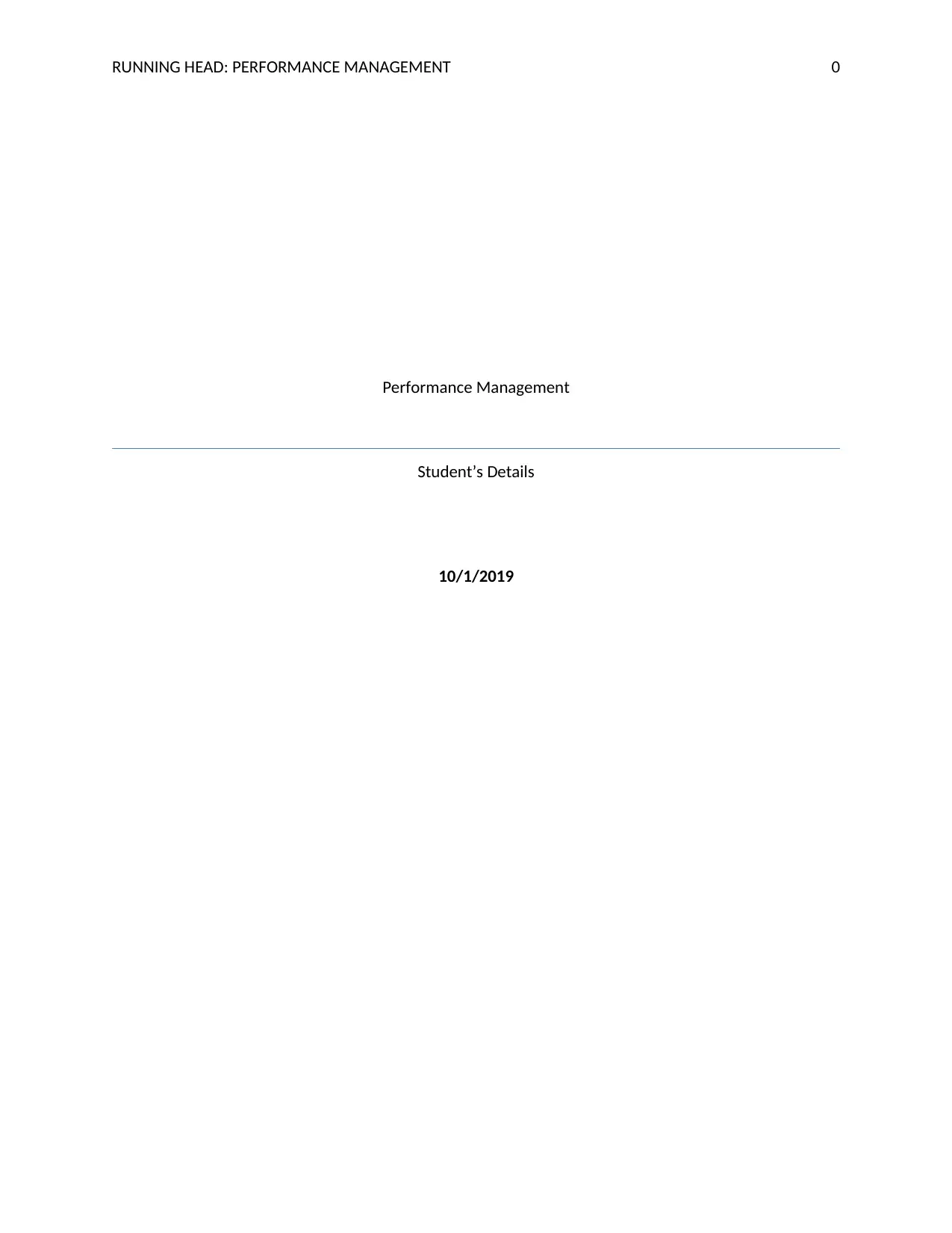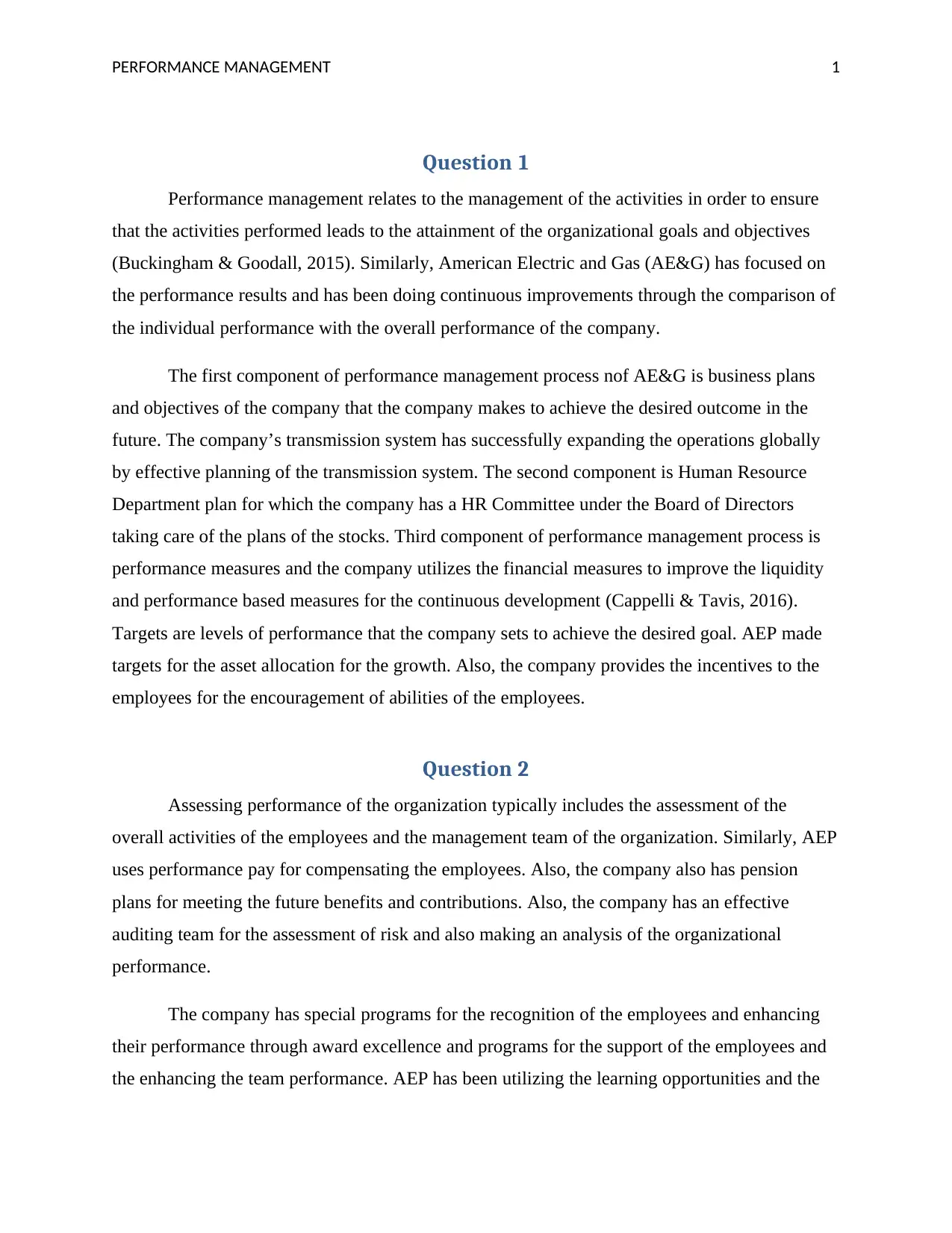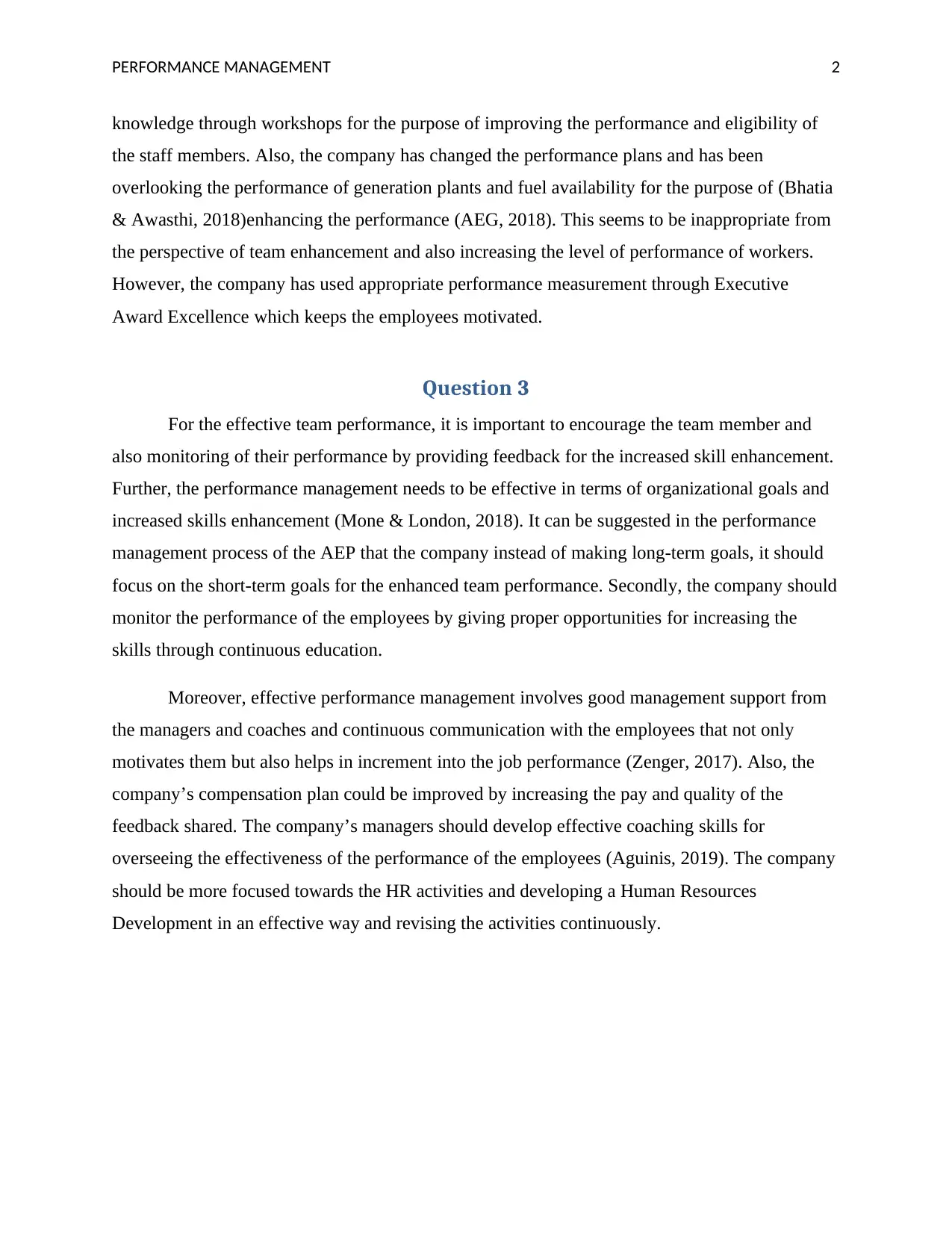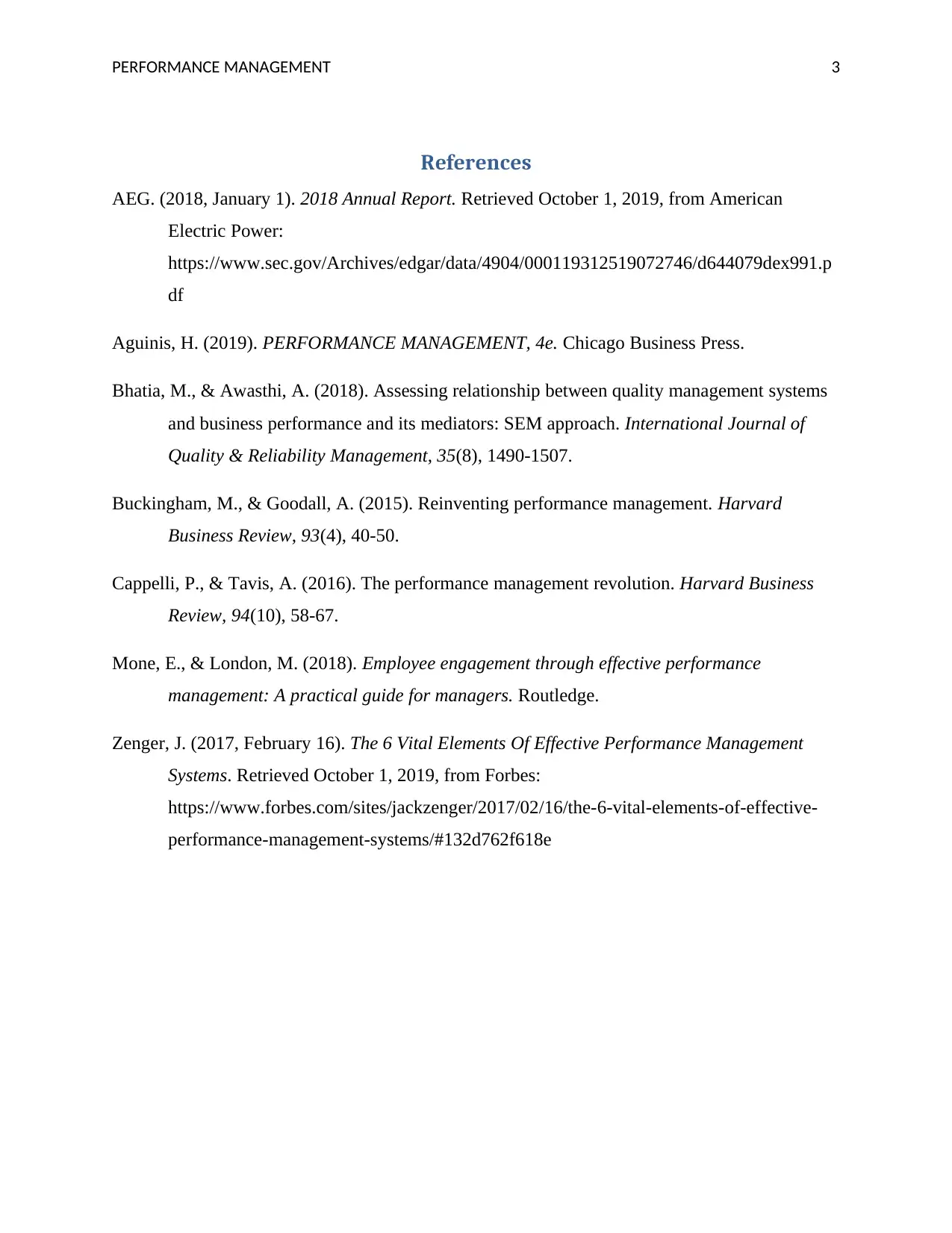Performance Management System Analysis: AE&G Case Study
VerifiedAdded on 2022/10/05
|4
|906
|195
Case Study
AI Summary
This case study analyzes the performance management system of American Electric and Gas (AE&G), a large public utility. The assignment examines the company's approach to aligning individual, team, and organizational goals, including business plans, HR strategies, and performance measures. It highlights the company's use of financial and performance-based metrics, target setting, and employee incentives. The analysis also assesses the effectiveness of the company's performance evaluation methods, including performance pay, pension plans, and employee recognition programs. The study suggests improvements, such as focusing on short-term goals, enhancing employee skill development, and improving compensation and feedback mechanisms to foster better team performance and employee engagement. The analysis also suggests the importance of effective coaching skills for managers and continuous improvement of HR practices.

RUNNING HEAD: PERFORMANCE MANAGEMENT 0
Performance Management
Student’s Details
10/1/2019
Performance Management
Student’s Details
10/1/2019
Paraphrase This Document
Need a fresh take? Get an instant paraphrase of this document with our AI Paraphraser

PERFORMANCE MANAGEMENT 1
Question 1
Performance management relates to the management of the activities in order to ensure
that the activities performed leads to the attainment of the organizational goals and objectives
(Buckingham & Goodall, 2015). Similarly, American Electric and Gas (AE&G) has focused on
the performance results and has been doing continuous improvements through the comparison of
the individual performance with the overall performance of the company.
The first component of performance management process nof AE&G is business plans
and objectives of the company that the company makes to achieve the desired outcome in the
future. The company’s transmission system has successfully expanding the operations globally
by effective planning of the transmission system. The second component is Human Resource
Department plan for which the company has a HR Committee under the Board of Directors
taking care of the plans of the stocks. Third component of performance management process is
performance measures and the company utilizes the financial measures to improve the liquidity
and performance based measures for the continuous development (Cappelli & Tavis, 2016).
Targets are levels of performance that the company sets to achieve the desired goal. AEP made
targets for the asset allocation for the growth. Also, the company provides the incentives to the
employees for the encouragement of abilities of the employees.
Question 2
Assessing performance of the organization typically includes the assessment of the
overall activities of the employees and the management team of the organization. Similarly, AEP
uses performance pay for compensating the employees. Also, the company also has pension
plans for meeting the future benefits and contributions. Also, the company has an effective
auditing team for the assessment of risk and also making an analysis of the organizational
performance.
The company has special programs for the recognition of the employees and enhancing
their performance through award excellence and programs for the support of the employees and
the enhancing the team performance. AEP has been utilizing the learning opportunities and the
Question 1
Performance management relates to the management of the activities in order to ensure
that the activities performed leads to the attainment of the organizational goals and objectives
(Buckingham & Goodall, 2015). Similarly, American Electric and Gas (AE&G) has focused on
the performance results and has been doing continuous improvements through the comparison of
the individual performance with the overall performance of the company.
The first component of performance management process nof AE&G is business plans
and objectives of the company that the company makes to achieve the desired outcome in the
future. The company’s transmission system has successfully expanding the operations globally
by effective planning of the transmission system. The second component is Human Resource
Department plan for which the company has a HR Committee under the Board of Directors
taking care of the plans of the stocks. Third component of performance management process is
performance measures and the company utilizes the financial measures to improve the liquidity
and performance based measures for the continuous development (Cappelli & Tavis, 2016).
Targets are levels of performance that the company sets to achieve the desired goal. AEP made
targets for the asset allocation for the growth. Also, the company provides the incentives to the
employees for the encouragement of abilities of the employees.
Question 2
Assessing performance of the organization typically includes the assessment of the
overall activities of the employees and the management team of the organization. Similarly, AEP
uses performance pay for compensating the employees. Also, the company also has pension
plans for meeting the future benefits and contributions. Also, the company has an effective
auditing team for the assessment of risk and also making an analysis of the organizational
performance.
The company has special programs for the recognition of the employees and enhancing
their performance through award excellence and programs for the support of the employees and
the enhancing the team performance. AEP has been utilizing the learning opportunities and the

PERFORMANCE MANAGEMENT 2
knowledge through workshops for the purpose of improving the performance and eligibility of
the staff members. Also, the company has changed the performance plans and has been
overlooking the performance of generation plants and fuel availability for the purpose of (Bhatia
& Awasthi, 2018)enhancing the performance (AEG, 2018). This seems to be inappropriate from
the perspective of team enhancement and also increasing the level of performance of workers.
However, the company has used appropriate performance measurement through Executive
Award Excellence which keeps the employees motivated.
Question 3
For the effective team performance, it is important to encourage the team member and
also monitoring of their performance by providing feedback for the increased skill enhancement.
Further, the performance management needs to be effective in terms of organizational goals and
increased skills enhancement (Mone & London, 2018). It can be suggested in the performance
management process of the AEP that the company instead of making long-term goals, it should
focus on the short-term goals for the enhanced team performance. Secondly, the company should
monitor the performance of the employees by giving proper opportunities for increasing the
skills through continuous education.
Moreover, effective performance management involves good management support from
the managers and coaches and continuous communication with the employees that not only
motivates them but also helps in increment into the job performance (Zenger, 2017). Also, the
company’s compensation plan could be improved by increasing the pay and quality of the
feedback shared. The company’s managers should develop effective coaching skills for
overseeing the effectiveness of the performance of the employees (Aguinis, 2019). The company
should be more focused towards the HR activities and developing a Human Resources
Development in an effective way and revising the activities continuously.
knowledge through workshops for the purpose of improving the performance and eligibility of
the staff members. Also, the company has changed the performance plans and has been
overlooking the performance of generation plants and fuel availability for the purpose of (Bhatia
& Awasthi, 2018)enhancing the performance (AEG, 2018). This seems to be inappropriate from
the perspective of team enhancement and also increasing the level of performance of workers.
However, the company has used appropriate performance measurement through Executive
Award Excellence which keeps the employees motivated.
Question 3
For the effective team performance, it is important to encourage the team member and
also monitoring of their performance by providing feedback for the increased skill enhancement.
Further, the performance management needs to be effective in terms of organizational goals and
increased skills enhancement (Mone & London, 2018). It can be suggested in the performance
management process of the AEP that the company instead of making long-term goals, it should
focus on the short-term goals for the enhanced team performance. Secondly, the company should
monitor the performance of the employees by giving proper opportunities for increasing the
skills through continuous education.
Moreover, effective performance management involves good management support from
the managers and coaches and continuous communication with the employees that not only
motivates them but also helps in increment into the job performance (Zenger, 2017). Also, the
company’s compensation plan could be improved by increasing the pay and quality of the
feedback shared. The company’s managers should develop effective coaching skills for
overseeing the effectiveness of the performance of the employees (Aguinis, 2019). The company
should be more focused towards the HR activities and developing a Human Resources
Development in an effective way and revising the activities continuously.
⊘ This is a preview!⊘
Do you want full access?
Subscribe today to unlock all pages.

Trusted by 1+ million students worldwide

PERFORMANCE MANAGEMENT 3
References
AEG. (2018, January 1). 2018 Annual Report. Retrieved October 1, 2019, from American
Electric Power:
https://www.sec.gov/Archives/edgar/data/4904/000119312519072746/d644079dex991.p
df
Aguinis, H. (2019). PERFORMANCE MANAGEMENT, 4e. Chicago Business Press.
Bhatia, M., & Awasthi, A. (2018). Assessing relationship between quality management systems
and business performance and its mediators: SEM approach. International Journal of
Quality & Reliability Management, 35(8), 1490-1507.
Buckingham, M., & Goodall, A. (2015). Reinventing performance management. Harvard
Business Review, 93(4), 40-50.
Cappelli, P., & Tavis, A. (2016). The performance management revolution. Harvard Business
Review, 94(10), 58-67.
Mone, E., & London, M. (2018). Employee engagement through effective performance
management: A practical guide for managers. Routledge.
Zenger, J. (2017, February 16). The 6 Vital Elements Of Effective Performance Management
Systems. Retrieved October 1, 2019, from Forbes:
https://www.forbes.com/sites/jackzenger/2017/02/16/the-6-vital-elements-of-effective-
performance-management-systems/#132d762f618e
References
AEG. (2018, January 1). 2018 Annual Report. Retrieved October 1, 2019, from American
Electric Power:
https://www.sec.gov/Archives/edgar/data/4904/000119312519072746/d644079dex991.p
df
Aguinis, H. (2019). PERFORMANCE MANAGEMENT, 4e. Chicago Business Press.
Bhatia, M., & Awasthi, A. (2018). Assessing relationship between quality management systems
and business performance and its mediators: SEM approach. International Journal of
Quality & Reliability Management, 35(8), 1490-1507.
Buckingham, M., & Goodall, A. (2015). Reinventing performance management. Harvard
Business Review, 93(4), 40-50.
Cappelli, P., & Tavis, A. (2016). The performance management revolution. Harvard Business
Review, 94(10), 58-67.
Mone, E., & London, M. (2018). Employee engagement through effective performance
management: A practical guide for managers. Routledge.
Zenger, J. (2017, February 16). The 6 Vital Elements Of Effective Performance Management
Systems. Retrieved October 1, 2019, from Forbes:
https://www.forbes.com/sites/jackzenger/2017/02/16/the-6-vital-elements-of-effective-
performance-management-systems/#132d762f618e
1 out of 4
Related Documents
Your All-in-One AI-Powered Toolkit for Academic Success.
+13062052269
info@desklib.com
Available 24*7 on WhatsApp / Email
![[object Object]](/_next/static/media/star-bottom.7253800d.svg)
Unlock your academic potential
Copyright © 2020–2025 A2Z Services. All Rights Reserved. Developed and managed by ZUCOL.





